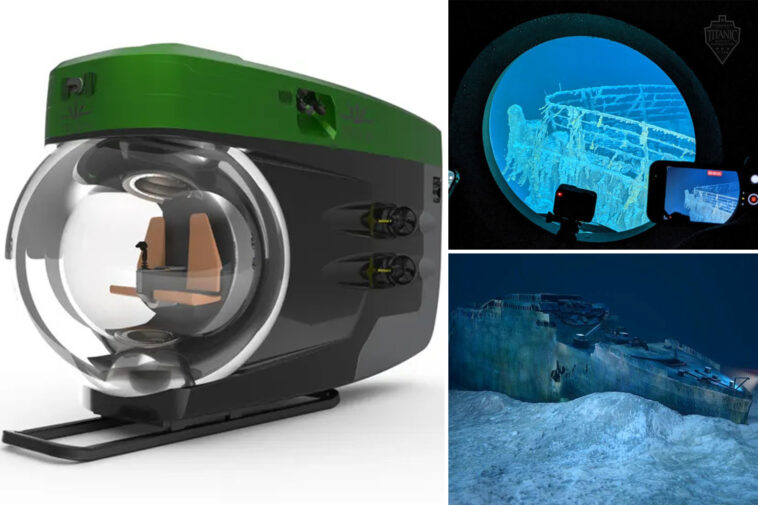The 1912 shipwreck of the Titanic has remained off limits for two years since the reckless Oceangate tragedy which killed five people instantly when their sub-par submersible imploded as it descended into the deep.
However, the Titanic — 12,500 feet below the surface of the North Atlantic Ocean — remains a huge draw for thrill-seeking billionaires and marine explorers alike.
In particular, those in the submersible industry are eager to send another manned craft to the wreck to try and restore public confidence in such missions.
“Besides it being a wreck of historical significance, the fact that it lies at such great depth makes it fascinating to visit,” Patrick Lahey, CEO of Triton Submarines, who is in the midst of building a new commercially available submersible that could handle such a journey, told The Post.
“Titanic is a wreck that’s covered in marine life and soft coral. People want to go there for the same reason that they want to climb Mount Everest.”
Making the trip costs a huge amount of money, so only the most rarefied can afford to do it. A handful of billionaires are known to have owned their own submersibles, including the late Paul Allen, co-founder of Microsoft; Ray Dalio, a Wall Street magnate and Russian oligarch Roman Abramovich.
The current chatter among elite ocean explorers is of an imminent new expedition, but the details are hush hush.
“I heard that somebody is going down to the Titanic in a couple weeks,” a knowledgeable source told The Post.
“What I can tell you is that it’s a billionaire. Going down there will cost $10 million. You would recognize his name.”
The source said they didn’t want to spoil the mystery billionaire’s surprise, adding: “He’ll want to make an announcement that he is the first person to go to the Titanic since the tragedy.”
Oceangate, the private company who launched the ill-fated Titan vessel, boasted it was the first to take ordinary tourists to see the Titanic, charging $250,000 per person.
However, CEO and captain Stockton Rush, who died in the disaster, has been accused of cutting corners. A US Coast Guard report released earlier this month said Titan imploded because its pressure hull where passengers sit was mostly made from fiberglass, rather than the more traditionally used titanium.
Rush also forewent safety tests and didn’t adequately repair and maintain the vessel, particularly after one incident in July 2022 when it got stuck in the Titanic wreckage and suffered “irreversible” hull damage.
Triton’s planned $20 million sub will be held to a much higher standard. Lahey has estimated it will be finished by next year.
“I’m very excited to be building this and to change the narrative,” he said.
Other manned submersibles can reach the depths of the Titanic, but are mostly operated by nation’s navies or marine research companies.
One such vessel is the Nautile, a French Deep Submergence Vehicle (DSV) capable of carrying up to three people to depths of 20,000 feet. That submersible was deployed in the desperate search for the Titan after it disappeared.
Meanwhile, DSV Alvin is an American-built submersible that previously dived to the Titanic for research, taking part in a 1986 expedition which produced some of the earliest and most iconic images of the famous wreck, first discovered a year earlier. The vessel carries two scientists and a pilot, and is currently owned by the United States Navy.
Russia’s navy has at least two DSVs known as Consuls, both able to dive to 20,000 feet with two passengers, while the Chinese-built and operated Striver can carry three crew members.
That vessel has dived to the deepest point on earth — the roughly 35,000-foot depth of Challenger Deep in the Mariana Trench, located in the Pacific near the coast of Japan.
That point has also been reached by the US built DSV Limiting Factor, built by Triton at a cost of $37 million. Since it was first deployed in 2018, it has taken some 21 people to Challenger Deep.
After being in the hands of a marine research organization until 2022, the sub was sold and is currently owned by Gabe Newell, a computer game mogul who most famously created Half Life. He has since renamed it Bakunawa and in 2024 it was used to make the first all-woman deep submersible dive to a depth of 26,000 ft carrying pilots Kate Wawatai and Heather Stewart.
For those less excited about marine research, the Titanic remains the wreck most want to visit. However, the trip is not for the faint of heart.
“It was the most dangerous dive I ever did – and I’ve been to the bottom of the ocean 15 times,” Victor Vescovo, a retired US Navy commander who originally piloted Limiting Factor, named for the spacecraft in a science fiction novel, told The Post.
“There are a lot of wires and entanglement and entrapment hazards with that wreck. You want to get close, so you can see it and so you can get good film [footage]. But the closer you get, the more dangerous it becomes.”
One thing you will want to get close enough to see are the shoes. “A good friend of mine, Jim Sinclair, was the first archaeologist to go down to the Titanic,” the treasure hunter Carl Allen told The Post. “And one of the things he always gets emotional about is the shoes. They are on the deck. You see the pairs and you start to wonder who had been wearing them.”















